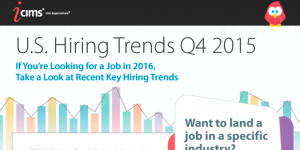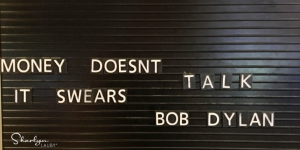Sharlyn J. Lauby's Blog, page 157
April 29, 2016
Recruiting Is Only Getting Tougher [infographic] – Friday Distraction
I believe one of the key metrics in recruiting is time to fill. It’s also a very flexible metric.
Traditionally, we think of time to fill as the time it takes from the job requisition being approved to the job offer being accepted. If the requisition is approved on April 1 and the job offer is accepted on April 29, then time to fill for that one job is 29 days. I’ve worked places where they also wanted to know time to start, meaning how many days until the employee’s first day. Using the same example, if the requisition is approved on April 1 and the employee starts work on May 15, then time to start is 45 days.
The reason I think this is an important metric is because time to fill has an impact on how companies make decisions.
Today’s infographic from our friends at iCIMS, shows data from their 2015 Hiring Trends report. Chief among the findings is the time it took employers to fill a job which averaged 44 calendar days.
An elongated time to fill can create challenges for employers which can affect their bottom line. CEB’s Global Labor Market Survey projects the average vacancy cost as $500 per day per open position. That means during the 44 days that companies are trying to fill a job, they are losing $22,000 in recruiting costs and productivity.
The full report and findings have lots of insights that can be helpful, especially during recruitment planning meetings. Also check out the interactive graph which displays talent supply/demand averages.
Recruiting is only getting tougher [infographic]
Click To Tweet
Recruiting dynamics aren’t getting any easier. Organizations that know their time to fill can put measures in place to mitigate losses. It could be utilizing a contingent workforce or temporary staffing. There’s also a case to be made for building a strong talent pipeline. It’s a clear example of how time really is money.
P.S. If meeting your recruiting goals is tops on your priority list, I hope you’ll join me and the iCIMS team on Tuesday, May 17 for a webinar on “How Companies Can Meet (and Exceed!) Their 2016 Recruiting Goals.” If you’re already booked that afternoon, remember you can sign up and listen to the archive later. The session is pre-approved for credit by the Human Resource Certification Institute (HRCI.)
The post Recruiting Is Only Getting Tougher [infographic] – Friday Distraction appeared first on hr bartender.






April 28, 2016
Quick Shots for #HR and #Business Pros – Freelancer Edition
Regardless of the reason, the gig economy is here to stay. Individuals are opting to have a side hustle in addition to their regular full-time jobs. Some people are choosing to leave the daily grind and freelance full-time. An article in Forbes put the number of freelancers in the U.S. at 53 million and predicts that number will increase to about 50% of the workforce by 2020.
If you’re trying to decide if being full-time employee or freelancing is right for you, check out this post I wrote on Unum’s WorkWell blog with the six advantages to consider for each.
I know one of the biggest challenges for freelancers is healthcare. My friends at The Devon Group told me about a partnership between Work Market, the leading on-demand marketplace for independent professionals, and Stride Health to offer its entire network of independent professionals across the United States access to affordable healthcare. Work Market’s partnership with Stride Health allows the company to connect its growing network of independent talent with more than 200 insurance carriers, as well as Stride’s recommendation platform, which compares 38 factors across thousands of health plans to find which plan will save a freelancer the most money, giving freelancers and their families more options.
But the gig economy isn’t something human resources should ignore. Organizations that want to take advantage of freelancer talent, need to consider how they are going to recruit and retain that talent. HR People + Strategy posted a good read titled, “HR in the Age of Gig.”
It also raises the question about training and professional development. Freelancing isn’t an excuse to stop learning. David Creelman penned an interesting post on Medium titled, “The problem of the ‘average Joe’ in the gig economy.”
Freelancers, consultants, contractors, whatever you want to call them, are a vital part of today’s economy and modern workplaces. There are tremendous advantages for organizations to have on-demand talent options. But, like everything, it means having a strategy, planning and executing that strategy well.
Images taken by Sharlyn Lauby while consulting around the globe for her clients
The post Quick Shots for #HR and #Business Pros – Freelancer Edition appeared first on hr bartender.






April 26, 2016
How Do You Change Company Culture – Ask #HR Bartender
A couple weeks ago, I participated in a webinar with my friends at SilkRoad on “HR’s Role in Bridging the Skills Gap.” During the webinar, we asked listeners about some of the strategies they were using, such as training, succession planning, and knowledge management. Afterward, I received an email with a question. And, it’s a tough question too.
How do you overcome management saying, “We’re not that kind of company.”?
Now more than ever, HR pros are trying to step up their game: promote the company’s employment brand, improve the candidate experience, develop future leaders, and create a more effective performance management process (just to name a few.) These are very important steps in attracting and retaining great talent. It can be incredibly frustrating to hear about new and innovative ways to manage talent only to have senior management reply, “That’s not really something we want to try. Go find another option.”
Bringing change into the organization is hard. If you’re trying to implement change, getting buy-in is essential. It can be one of the ways to introduce new ideas. Find a member of the senior management team who’s willing to listen. Get them to help sell the change. A couple of years ago, I had the privilege of interviewing Dr. John Kotter from Harvard University for a piece on organizational change. It’s a good read about the process of buy-in.
But I think there’s a bigger issue. We touched on it during a Twitter chat with The Workforce Institute discussing company culture. That is, understanding the definition of culture, who drives it, and what are the key components. If we don’t know what makes up our company culture, how can we change it?
Then the question becomes, if we have a firm grasp on what our organizational culture is, then we should know when our proposals are going to be a major deviation from existing culture. And we should be prepared to set-up the conversation accordingly.
“On this surface, this idea doesn’t align with our culture. But let me tell you why I think we need to consider it AND how I think we could make it work.”
When we propose a new idea, it’s not for grins and giggles. It is because we need to address an issue impacting the business. That’s where we need to start. Acknowledge the problem. Then, be prepared to discuss why the idea or proposal is worth making a company culture change. I can’t guarantee that the answer will be “yes” but it could open the door to a different discussion – one that puts the root cause of the problem on the table for discussion.
This is how you change company culture.
Click To Tweet
It’s also sad to say that sometimes, no matter how many times we propose change, the answer will be “no.” At some point, you have to realize, it’s not you. The organization doesn’t want to change. And ask yourself, if you’re okay with that being the way things go.
Image taken by Sharlyn Lauby at a public demonstration (with permission of course)
The post How Do You Change Company Culture – Ask #HR Bartender appeared first on hr bartender.






April 24, 2016
Recruiters Must Learn Talent Development (and vice versa)
Last year, I saw something at a conference that surprised me. A speaker asked an audience of about 100 human resources professionals – who has a kickass talent acquisition function. The surprise? Not one person raised their hand.
I get it. Recruiting is tough right now. But not one person raised their hand. I could understand if half of the audience didn’t raise their hand, but not one. It was eye-opening for sure.
The speaker turned the conversation toward the reasons that recruiting is struggling to meet the needs of the organization. Whether it’s candidate quality, time to fill, cost per hire…or any combination of…there’s a disconnect.
But it occurred to me as the discussion was taking place that part of the solution lies in the organization’s talent development efforts. I know it’s tempting to think of talent development as simply the newfangled word for training, but it really is more than that. Talent development also includes career management and development, organizational development, and activities like succession planning.
All things employees want.
I happen to believe that, in order to become good at talent development activities like succession planning, you must understand recruiting. Think about it. How can you create a plan to develop talent within the company if you don’t understand where and how to attract the best talent? How can you manage a plan to develop talent within the organization if you don’t understand what talent needs to be development (versus hired from the outside)?
Conversely, recruiters need to understand talent development. They need to know that the candidates being hired will fit into the organization’s succession and/or replacement plans. They also need to understand how the company’s programs will elevate the candidate’s skills to fit the future needs of the organization.
I completely understand the need for specialization. Some people say the human resources generalist is dead. But this doesn’t mean that we are absolved of our responsibility to understand how the pieces of the HR function fit together. Both talent acquisition and development professionals need to use the same talent terms. I heard a couple of new ones during this session:
Ready Now – Short referring to employees who are able to assume new roles during the next 1-2 years.
Ready Now – Long meaning employees who are able to assume new roles during the next 3-5 years.
This does raise the question: in addition to thinking about the talent pipeline, it’s necessary to think about where the business will be short term (1-2 years) and long term (3-5 years). Both talent development and acquisition professionals must be able to identify and develop skills that the company doesn’t even need yet.
Recruiting and training specialist need to learn about each other’s roles.
Click To Tweet
Organizations continue to be challenged with finding and keeping the best talent. While one aspect to solving this challenge is looking at company culture, another piece is making sure that the company’s efforts to hire and development talent are aligned with the business. Recruiting and training specialists need to learn about each other’s roles and collaborate to deliver – and develop – the best talent.
Image taken by Sharlyn Lauby after speaking on Human Resources change in Reykjavik, Iceland
The post Recruiters Must Learn Talent Development (and vice versa) appeared first on hr bartender.






April 22, 2016
U.S. Fails on Paid Parental Leave [Infographic] – Friday Distraction
The United States does many things well, but one place where we’re missing the mark is paid parental leave. The U.S. is 1 of only 4 countries that does not offer federally mandated paid parental leave to anyone. We’re the only industrialized country to offer zero weeks of paid leave for new mothers. And 70 percent of fathers who take parental leave average ten days or less.
Even if the government doesn’t enact a law, that doesn’t mean that the issue should go unnoticed. Because offering parental leave is just good for business.
This infographic from Jobvite and our friends at ColumnFive Media offers some insight about parental leave benefits. The graphs that show the employer assessment of paid family leave by company size are worth noting. Paid parental leave helps improve morale, maintain productivity, and decrease turnover. All part of employee engagement and huge concerns for businesses.
The other thing I noticed about this infographic is that the benefits are not limited to a certain company size. I remember reading an article last year from the Great Place to Work Institute that said the 100 Best Companies to Work For average 68 days off for maternity leave. That might leave the reader with the impression that paid leave is only for big companies. But then I see an article in Fast Company about a start-up that offers paid maternity leave.
This conversation is starting to heat up for U.S. businesses. Organizations need to realize that paid parental leave will be a key differentiator for attracting and retaining candidates and employees. Then decide what side of the conversation they want to be on to compete for talent.
The post U.S. Fails on Paid Parental Leave [Infographic] – Friday Distraction appeared first on hr bartender.






April 21, 2016
Well-Being Impacts Performance Management
There appears to be a full blown rebellion of the annual performance review. I’m still not convinced that the answer is to ditch the appraisal process. Even if your organization has transitioned to a series of shorter feedback sessions instead of the annual review, it’s possible the symptoms that plague the annual review will surface: manager bias, lack of valuable feedback, inconsistency, etc.
But as I was typing the list of challenges facing performance reviews, it occurred to me…I wonder if some of these symptoms are due to manager fatigue and burnout? Think about it, we talk about employee stress all the time. If employees are overwhelmed, what are the chances that the manager is overwhelmed too?
We know well-being has an impact on employee engagement and performance. It only seems logical that manager well-being has an impact on manager’s engagement and performance too. Organizations need to address manager well-being if they want managers to be effective coaches and mentors within their teams.
The reason I’m bringing this up is because sometimes organizations hold managers accountable at a different level. Last minute deadline? The manager can stay late to handle it. Understaffed and no overtime in the budget? The manager will come in on their day off. Now managers also get the benefit of occasionally walking in the door late or leaving early too. But we have to make sure the relationship is one of give and take, versus always in the company’s favor.
Well-being has an impact on performance management. If managers don’t feel good and aren’t on top of their game, how can they be expected evaluate someone else’s performance objectively?
While I’m on the subject, let’s take this conversation one step further. How can human resources effectively manage the performance management process if they are stressed out? I think it’s time we recognize that well-being applies to management and human resources too. I’ll admit it, there are times when HR is so busy making sure everyone else has balance, they forget about themselves. And sometimes it’s a challenge to admit that we need time to recharge.
Organizations cannot view the need for well-being as being selfish. It’s self-awareness. Each individual must learn to identify their stressors and understand how to manage them. If organizations expect employees to perform at a high level, they must have well-being. That goes for human resources and management too. Otherwise the performance management system isn’t operating at full effectiveness.
Image taken by Sharlyn Lauby while attending the Great Place to Work Conference
The post Well-Being Impacts Performance Management appeared first on hr bartender.






April 19, 2016
Should You Include Your Photo On Your Resume – Ask #HR Bartender
On the surface, this question might appear like a no-brainer, but there are more nuances to the situation than you think.
Do you think people should put their image on their CV’s? We’re doing so many headshots for LinkedIn but not sure about CV.
This note doesn’t mention resumes, but let’s include them anyway because many people use the terms interchangeably. And start by addressing the difference between a resume and curriculum vitae (also known as CV.) Curriculum Vitae is Latin for “course of life.” It typically presents a full history of your background, tailored to the audience it’s being sent to. Examples include an academic position or a private sector job opening. By contrast, resume is French for “summary.” It is also tailored for use but it tends to be shorter (because it’s a summary) and more concise.
To offer some perspective on this issue, I reached out to a couple of colleagues who spend a lot of time looking at resumes. Lisa Rangel is president of Chameleon Resumes and a LinkedIn Job Seeker Premium Group Moderator. She’s a certified professional resume writer and her website is listed as one of the Top 100 Career Websites by Forbes.com. Steve Levy is a principal with Recruiting Inferno Consulting, which provides talent acquisition and career planning solutions to organizations. He’s famous for being ERE.net’s first blogger and an influencer in the recruiting space.
While I wouldn’t say it doesn’t happen, in the United States, photos on recruiting documents is not the norm. Rangel and Levy explain why.
[Rangel] In the U.S., a picture is not necessary on a resume. I would even say it’s frowned upon by recruiters. In the U.S., employers are to make employment decisions based on qualifications, and not appearance, race, gender, and other categories protected by labor laws. Photos give information that shouldn’t contribute to a hiring decision. Therefore, resumes in the U.S. don’t need and shouldn’t have pictures. Including a photo on U.S. resumes can send a message that the candidate doesn’t understand hiring protocols. Outside the U.S., many countries/employers require a photo and it is more customary to include a headshot.
[Levy] It seems that every two years or so, another research study re-confirms that bias and resume/CV go together. Research like this has been taking place for decades. Don’t believe me? Google/Bing the phrase ‘resumes and bias’ and enjoy hours of reading: same resume, different gender, race, nationality, name…when asked who do you believe would be more successful on the job, the results fall in line with societal biases. And some ‘experts’ are calling for job seekers to put their image on their resumes? Can you make it any easier to discriminate? This is quite the slippery slope!
That being said, if you do decide to include your headshot on your resume/CV, Rangel explains the advantages and disadvantages of doing so.
 [Rangel] If you are in a profession where appearance is important, and your appearance demonstrates the favorable traits needed in that job, having a photo that demonstrates those traits can be an advantage. And for applications outside the U.S., having a photo can make your resume seem more compliant with application requirements and customs.
[Rangel] If you are in a profession where appearance is important, and your appearance demonstrates the favorable traits needed in that job, having a photo that demonstrates those traits can be an advantage. And for applications outside the U.S., having a photo can make your resume seem more compliant with application requirements and customs.
On the downside, even if your picture demonstrates favorable traits, including a photo for U.S. resumes can put forth an impression that the applicant doesn’t understand hiring protocols, which could be exceptionally damaging for leadership roles, with whom hiring decisions are made. Or that the candidate is trying to gain favorable advantage with traits that are not pertinent to the position. Additionally, some hiring systems simply purge resumes/applications that include photos.
Photos on your resume – everything we need to know.
Click To Tweet
The reader brings up a good point about LinkedIn. With the popularity of social media, it’s relatively easy to find out what people look like. Should candidates treat their resume/CV different from LinkedIn?
 [Levy] It’s an interesting question that begs a specific discussion: If having a LinkedIn profile is a de facto standard for job seekers (and I don’t believe that it is – but my view is based on the quality of the platform, not the process of a job search), and the platform strongly suggests that a profile include a ‘professional profile picture,’ then at some time in the future, national employment laws might impact the future presence of these pictures.
[Levy] It’s an interesting question that begs a specific discussion: If having a LinkedIn profile is a de facto standard for job seekers (and I don’t believe that it is – but my view is based on the quality of the platform, not the process of a job search), and the platform strongly suggests that a profile include a ‘professional profile picture,’ then at some time in the future, national employment laws might impact the future presence of these pictures.
The fact of the matter is that much like the gender, race, nationality, name research above, people do look at profile pictures and make assessments of a person’s potential fit and performance – what we call ‘implicit bias’ decisions. Yet if someone is going to be so boneheaded to judge you on your gender, race, nationality, name – or perceived attractiveness – do you really want to work with these Neanderthals? Haters are always gonna hate…
The real issue here is whether or not your LinkedIn profile/resume/CV – with or without a picture – is performance focused in its language (incidentally, the difference between the LinkedIn profile and resume is that the profile is a resume on steroids – you can add a good deal more detail to your profile that you would normally not include on your resume). Organizations hire people to solve problems and what catches my eye are people who can articulate the problems they’ve solved, the before and after metrics, and the impact of their solutions.
At the end of the day, I don’t mind looking at your picture because I’m hiring people not just words on a piece of paper. Add to this, descriptions of your performance, and you’re showing me a whole person.
If a person does decide to include their headshot on their resume/CV, can you share one “must-do” and “definitely don’t do”?
[Rangel] If a person is including their photo, I would follow the guidelines for a LinkedIn profile photo closely. Ensure that it is a professional crippled headshot. Be mindful of the background. Strive for a casually elegant business appearance, unless wearing a suit is paramount for the person’s industry. I would not do photos from a distance or mugshot looking photos.
My thanks to Steve and Lisa for sharing their expertise. If you want to hear more from them, be sure to follow them on Twitter: @LevyRecruits and @LisaRangel. Both of them offer great insights on recruiting, jobs, and careers.
Image courtesy of Sharlyn Lauby taken just off the coast of Mexico.
The post Should You Include Your Photo On Your Resume – Ask #HR Bartender appeared first on hr bartender.






April 17, 2016
Educating Your Employees About Their Compensation
I recently heard a speaker talk about employee pay and engagement. They said, “Misunderstood pay can be a huge distraction.” They’re absolutely right. But, misunderstanding pay is different from being disappointed or frustrated about pay. I’d like to think if an employee doesn’t understand their compensation, it can be resolved with education.
First and foremost, candidates need to know how the company establishes starting wages. Most organizations have a philosophy when it comes to hiring and negotiating starting salaries. They have a range that they’re working with. It’s important to let candidates know whether they’re in the ballpark. Otherwise, the company and the candidate are wasting their time. And the conversation will end up frustrating everyone.
HR must let employees know about all of the benefits and perks they have. I’ve been surprised many times in my career that employees were not aware of their benefits. I felt HR was really getting the word out about a benefit and obviously not. HR has to find a way to remind employees of their benefits.
Employees need to understand the relationship between pay, benefits and perks. There’s more to compensation than the amount of money in an employee’s paycheck. I’ve worked in several industries where the pay was low but the benefits were fantastic. It’s important to speak in terms of total compensation and let employees know how that is determined.
New employees should learn in orientation how pay increases work. If companies are linking pay and performance, then employees need to understand how the system works. This includes when performance reviews happen, when employees are eligible for increases, and how the company determines pay increase amounts. If the company offers a bonus program, this also includes bonuses and how they are calculated.
Managers can inform employees how performance impacts promotions and transfers. One way that employees can advance their careers (and their compensation) is by accepting a promotion or transfer. Managers will want to let employees know how the process works and the eligibility requirements.
Organizations need to let employees know that they survey wages. I once worked for a company that told employees, “We survey employee compensation every year.” It didn’t guarantee that wages were going to change, but it did let employees know that the company was committed to staying on top of the data.
Organizations could alleviate a lot of frustration if they educate their employees about compensation. Employees who understand the system might take more advantage of company benefits and perks. They could be better prepared to ask for pay increases.
But even employees who understand their pay, can be frustrated by it and disappointed. Organizations need to conduct regular surveys to ensure their compensation packages are internally equitable and externally competitive. Misunderstood pay can be a huge distraction – for both the employee and the company. The good news is that it can be addressed with proper communication.
Image taken by Sharlyn Lauby after speaking at the HR Change & Transformation Conference in London, England
The post Educating Your Employees About Their Compensation appeared first on hr bartender.






April 15, 2016
Happy Employees = Happy Customers [Friday Distraction]
(Editor’s Note: Today’s post is brought to you by our friends at Kronos , the global leader in delivering workforce management solutions in the cloud. Tens of thousands of organizations in more than 100 countries – including more than half of the Fortune 1000® – use Kronos to control labor costs and improve workforce productivity. Enjoy the post!)
I imagine I’m like most people and I enjoy purchasing an item when it’s on sale. It’s a great feeling to know that I scored a deal. Especially when it comes to shoes, but that’s another post.
But I will also admit there are times when I will spend more to eliminate a hassle. An example for me is the pharmacy. I could refill prescriptions online or via mail and save a couple of dollars. But my mail order prescription service is inefficient and unreliable. So I just go to my local Target pharmacy.
Oh, and let me add…my Target has the friendliest staff. They know me by name. Yes, my Target store pharmacy knows me by name and I go there less than once a month. THAT is service. I don’t know that I would have expected that from a large retailer in a tourist destination. But they deliver. And that matters to me.
Our friends at Kronos have nailed the secret to happy customers (and growing profits) in this special Time Well Spent video.
As a consumer, you can tell when employees don’t like their job. Employees might be able to fake it for a day or possibly a week, but they can’t fake it long-term. Sure, a disengaged employee might think they’re fooling people, but they’re not. Happy employees who like their work are a true pleasure to do business with. You don’t mind giving them your money. In fact, I hate to say it but I probably need to show more restraint. Because happy employees make you want to shop more.
As business leaders, it’s our job to create workplaces that support employees. We need to hire for cultural fit, offer competitive pay and benefits, train employees to do their work, and develop them for future opportunities. That is what makes employees happy.
…and your customers happy as well.
The post Happy Employees = Happy Customers [Friday Distraction] appeared first on hr bartender.






April 14, 2016
Standup Meetings Help Build Transparency
There are only three types of meetings: informational meetings, problem solving meetings, and feedback meetings. Within each of these types of meetings are narrower categories; for example, a brainstorming meeting can be considered a feedback meeting because the purpose is to get feedback (in the form of ideas) about a particular issue.
One of the most effective types of informational meetings is the standup meeting. The reason it’s called a standup is because the meeting is so short that most of the time people can stand for the meeting (unless of course they are unable.) The purpose of the standup is to conduct an incredibly brief meeting dispensing only the absolutely essential information.
Let’s backtrack for a second. I believe standups came into being because sit down meetings take too long. I’m not opposed to long meetings, as long as they’re needed. However, I must admit it’s rare to have a 10-15 minute sit down meeting.
It’s sad to say but some people feel that, if they call a meeting, they must talk for a certain length of time (like the quality of the meeting is directly proportional to the length of the meeting.) So in some organizations, sitting in a conference room means the meeting will take a minimum of 30 minutes. In others, it might mean a one-hour minimum.
I think this is something that we have been conditioned to accept and expect over the years. Standup meetings may help change that:
Standups are regularly scheduled quick meetings. Usually held in an open space, standups are designed to quickly share information. And I mean quickly. This meeting shouldn’t last over 10 minutes. Fifteen tops.
Standups are designed to pass along work information. In my experience, standups are conducted at the beginning of shifts. The purpose is to give the team information they needed for the day. The departing shift would debrief the arriving shift. If something happened with a customer and the arriving shift needed to follow-up, this was where the information was passed along. They aren’t designed for long philosophical conversations. They aren’t for complex issues. They are a quick, “Here’s what you need to know. Have a great day.”
Standups are best when the team doesn’t become complacent. Even short shift briefings can become a bit routine. One thing I’ve seen done in my past experience to keep people on their toes (no pun intended) was schedule the briefing at an odd time. We found briefings at the quarter hour (i.e. :00, :15, :30, :45) automatically took longer because people were late. So we conducted standups at :50 or :20.
Standups can bring the team together. Senior management team can use standup meetings to occasionally recognize and reward employees during standups. Nothing elaborate but, looking back on my experience with standups, it was nice to hear, “Before we end, let’s give a shout out to Bill for passing his certification exam.” Or “I want to thank everyone for working so hard on this project. I’ve got Starbucks gift cards for everyone. Have a coffee on me today.”
Standup meetings can educate the business. The meeting allows everyone to hear what’s going on in the organization. Standups shouldn’t be people-specific or department-specific. If you’re working, you’re welcome to attend. Depending upon the operation, maybe someone does need to stay and take care of customers, but one representative can attend and bring back information. In fact, employees can take turns attending the standup, so they are able to build relationships around the organization.
A few years ago, transparency was a much talked about concept. Then it fell into the corporate buzzword category and faded a bit. I’m hearing people talk about transparency again. Maybe we’ve realized that the concept of making sure employees know what is going on in the business is important – even if the term for it is considered a buzzword. Standup meetings are a great way to share what’s happening in the company and build a team.
Image taken by Sharlyn Lauby at the Gainesville 34th Street Graffiti Wall
The post Standup Meetings Help Build Transparency appeared first on hr bartender.






Sharlyn J. Lauby's Blog
- Sharlyn J. Lauby's profile
- 10 followers















